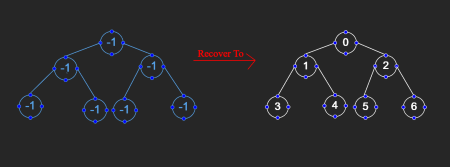Find Elements in a Contaminated Binary Tree
Problem Statement
You are given a contaminated binary tree where all TreeNode.val have been changed to -1. The tree follows these rules:
- The root node has a value of
0. - If a node has a value
x, then:- Its left child (if exists) will have a value
2 * x + 1. - Its right child (if exists) will have a value
2 * x + 2.
- Its left child (if exists) will have a value
Task
Implement the FindElements class:
FindElements(TreeNode* root): Initializes the object with a contaminated binary tree and recovers it.bool find(int target): Returnstrueif thetargetvalue exists in the recovered binary tree, otherwise returnsfalse.
Test Case 1: Single Node Tree
Input
["FindElements","find","find"]
[[[-1]],[0],[1]]

Output
[null,true,false]
Explanation
FindElements findElements = new FindElements([-1]);
findElements.find(0); // returns True (root is always 0)
findElements.find(1); // returns False (no left or right child exists)
Test Case 2: Complete Binary Tree of Height 3
Input
["FindElements","find","find","find","find","find"]
[[[-1,-1,-1,-1,-1,-1,-1]],[3],[5],[6],[7],[8]]

Output
[null,true,true,true,false,false]
Explanation
FindElements findElements = new FindElements([-1,-1,-1,-1,-1,-1,-1]);
findElements.find(3); // returns True
findElements.find(5); // returns True
findElements.find(6); // returns True
findElements.find(7); // returns False (no node with value 7 exists)
findElements.find(8); // returns False (no node with value 8 exists)
Constraints
- The height of the binary tree is .
- The total number of nodes is in the range .
- will be called at most times.
- .
Approach
- Recover the tree using DFS or BFS:
- Start from the root and assign it
0. - For each node
x, assign its left child2 * x + 1and right child2 * x + 2. - Store these values in a
setorunordered_setfor quick lookup.
- Start from the root and assign it
- Find operation in O(1):
- Use a hash set to store valid node values for
O(1)lookup in thefind()function.
- Use a hash set to store valid node values for
Category:- Leetcode Problem of the Day
- Binary Trees
Programming Language: - Java
Reference Link:
https://leetcode.com/problems/find-elements-in-a-contaminated-binary-tree/description/
Java
Output:
Loading component...
Loading component...